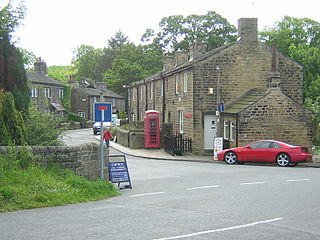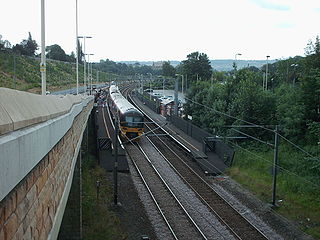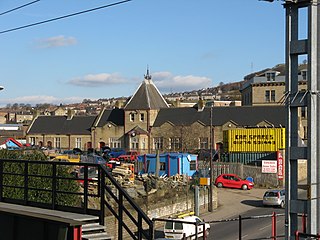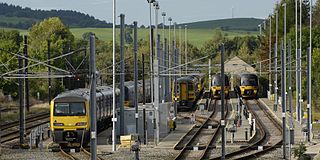
Esholt is a village and former civil parish in the metropolitan district of the City of Bradford, West Yorkshire, England. It is situated 3 miles (4.8 km) east of Shipley town centre, 1.5 miles (2.4 km) south-west of the A65 in Guiseley, 7 miles (11 km) north of Bradford City Centre, and 10 miles (16 km) north-west of Millennium Square, Leeds.

The Bradford Canal was a 3.5-mile (5.6 km) English canal which ran from the Leeds and Liverpool Canal at Shipley into the centre of Bradford. It opened in 1774, and was closed in 1866, when it was declared to be a public health hazard. Four years later it reopened with a better water supply, and closed for the second time in 1922. It was subsequently filled in, although consideration has been given to restoring it. There are some remains, including a short section of canal at the junction and a pumping station building, which is now a dwelling.

The Wharfedale line is one of the rail services in the West Yorkshire Metro area of northern England. The service connects Ilkley with Leeds and Bradford, and is operated by Northern Trains. West Yorkshire Metrocards are available for use on the line, covering Zones 3–5. The line is served predominantly by four-coach Class 333 electric multiple units as well as some three-coach Class 331 EMUs.

The Airedale line is one of the rail services in the West Yorkshire Metro area centred on West Yorkshire in northern England. The service is operated by Northern, on the route connecting Leeds and Bradford with Skipton. Some services along the line continue to Morecambe or Carlisle. The route covered by the service was historically part of the Midland Railway.

Ilkley railway station serves Ilkley in the City of Bradford, West Yorkshire, England. On the Wharfedale Line, it is served by Class 333 electric trains run by Northern Trains, which also manages the station.

Frizinghall railway station is situated in the Frizinghall district of Bradford, West Yorkshire, England. It is an unstaffed halt on the Airedale Line, 2 miles (3 km) north of Bradford Forster Square. The station, and all trains serving it, are operated by Northern Trains.

Saltaire railway station serves the Victorian model village of Saltaire near Shipley in West Yorkshire, England. It is situated 3+1⁄2 miles (6 km) north of Bradford Forster Square.

Bingley is a grade II listed railway station that serves the market town of Bingley in West Yorkshire, England. It is located 13.5 miles (21.7 km) from Leeds and 5.5 miles (8.9 km) away from Bradford Forster Square, on the Airedale line; services are operated by Northern Trains.
The Leeds and Bradford Railway Company (L&BR) opened a railway line between the towns on 1 July 1846. It extended its line from Shipley through Keighley to Skipton and Colne, in 1847 and 1848.

Thackley Tunnel is on the Airedale line between Leeds and Shipley on the lines to Bradford and Skipton.

Barnoldswick was the only railway station on the Midland Railway's 1-mile-64-chain (2.9 km) long Barnoldswick Branch in the West Riding of Yorkshire in England ; it served the market town of Barnoldswick. The line left the Leeds and Bradford Extension Railway at Barnoldswick Junction 55 chains from Earby. The line through the junction was on a 20-chain radius after which it converged to a single track and ran in a straight but undulating line to Barnoldswick. The passenger train that ran back and forth between Barnoldswick and Earby was known locally as the Barlick Spud or Spudroaster. The real reason for the name is lost in time, but the two versions that were commonly recited are that the original branch locomotive was so small it looked like a portable potato roaster used by a local vendor or that the journey time was the same as that taken to roast a potato in the locomotive's firebox.

Thackley is a small suburb near Bradford, West Yorkshire in England. The village is loosely bordered by the village of Idle to the south, to the west by the West Royd area of Shipley and elsewhere by the Leeds and Liverpool Canal. Thackley is the northernmost part of Bradford south of the River Aire.

The Leeds and Bradford Extension Railway was an early British railway company in the West Riding of Yorkshire. It built a line from Shipley near Bradford through Keighley and Skipton to Colne. The Skipton–Colne Line closed in 1970, but the remainder of the line is still in use today, and once formed part of the Midland Railway's main line route from London to Glasgow.

Esholt railway station was a railway station on the Shipley to Guiseley line of the Midland Railway. It opened on 4 December 1876 along with Baildon station when the line was formally opened, and closed on 28 October 1940. The buildings remained after closure before being demolished in 1953.

The Shipley Great Northern Railway branch line was a railway line that ran east, south and then westwards from Shipley to Bradford in West Yorkshire, England. The route was opened in 1874 to goods traffic and then to passengers in 1875 by the Great Northern Railway (GNR) and looped around the eastern edge of Bradford. The GNR arrived after other railways had been established in the West Yorkshire area and many of their lines were heavily reliant on tunnels and grand viaducts, the Shipley and Windhill line being an exception to this, although it did have some steep gradients. The branch extended for 8.5 miles (13.7 km) between the two terminuses of Shipley Windhill and Bradford Exchange. The route as built from Laisterdyke to Shipley was actually only 6.5 miles (10.5 km) as the initial section from Bradford Exchange to Laisterdyke was already in existence as part of the Great Northern Railway's line to Leeds.

Skipton Broughton Carriage Sidings are located in Skipton, North Yorkshire, England, on the Airedale Line just west of Skipton station. It derives its name from Broughton Road, which runs parallel to the facility. The sidings are located on the opposite side of the railway to where the former Skipton Engine shed was located, which closed in 1967.

Bradford Dale, is a side valley of Airedale that feeds water from Bradford Beck across the City of Bradford into the River Aire at Shipley in West Yorkshire, England. Whilst it is in Yorkshire and a dale, it is not part of the Yorkshire Dales and has more in common with Lower Nidderdale and Lower Airedale for its industrialisation.
Manningham Engine Shed was a railway depot located in the Manningham suburb of Bradford in West Yorkshire, England. The depot was built to provide steam engines for services leaving Bradford Forster Square station and freight traffic from the Valley Road area of the city. It was also responsible for other sites at Keighley and Ilkley with Manningham itself being a sub-shed of Holbeck.
Hellifield Engine Shed was a railway locomotive depot adjacent to Hellifield railway station in North Yorkshire, England. The depot opened in 1880 and was closed in 1963. Its main function was to house engines for use on the Settle-Carlisle line.

The Apperley Viaducts are two adjacent railway viaducts straddling the River Aire in West Yorkshire, England. The open viaduct dates back to 1900, carrying the current double track Airedale line railway, whereas the redundant adjacent viaduct dates back to 1867, and was built to replace the original bridge at this point which collapsed in November 1866 due to severe flooding. The viaducts are two of the many railway crossings of the River Aire between Shipley and Leeds.

















